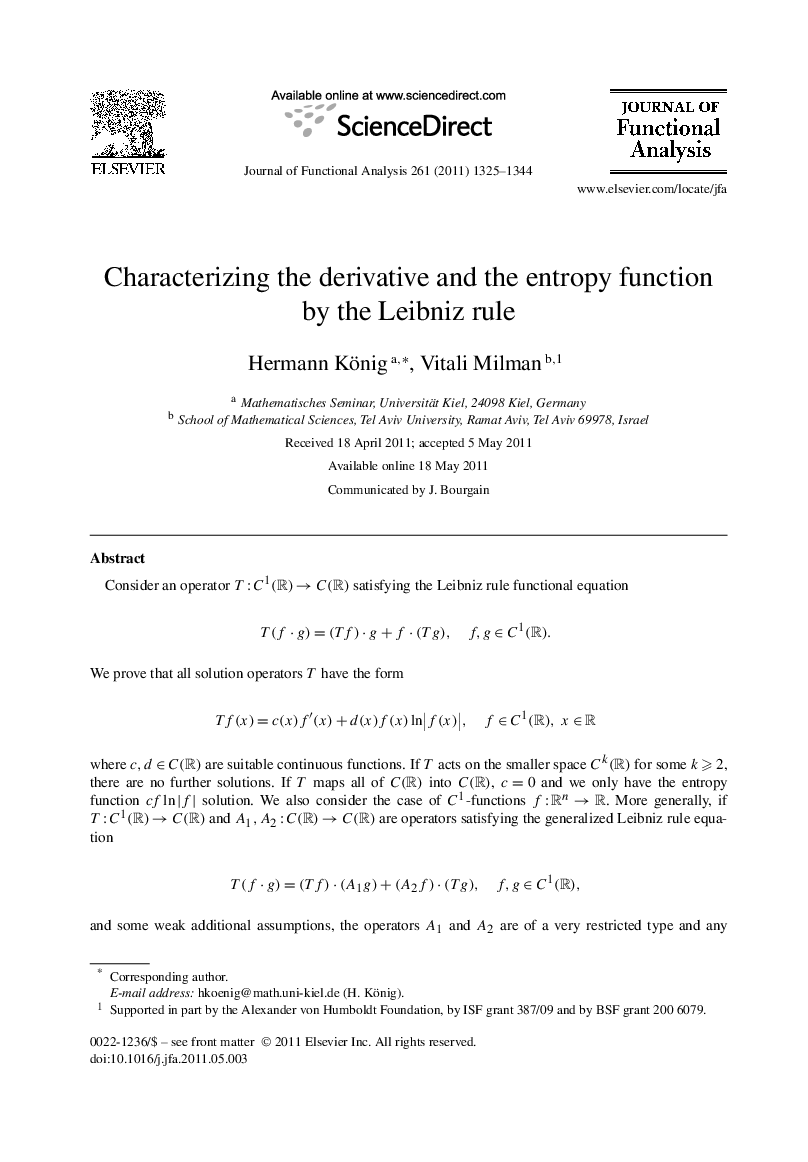| Article ID | Journal | Published Year | Pages | File Type |
|---|---|---|---|---|
| 4590987 | Journal of Functional Analysis | 2011 | 20 Pages |
Consider an operator T:C1(R)→C(R)T:C1(R)→C(R) satisfying the Leibniz rule functional equationT(f⋅g)=(Tf)⋅g+f⋅(Tg),f,g∈C1(R). We prove that all solution operators T have the formTf(x)=c(x)f′(x)+d(x)f(x)ln|f(x)|,f∈C1(R),x∈R where c,d∈C(R)c,d∈C(R) are suitable continuous functions. If T acts on the smaller space Ck(R)Ck(R) for some k⩾2k⩾2, there are no further solutions. If T maps all of C(R)C(R) into C(R)C(R), c=0c=0 and we only have the entropy function cfln|f|cfln|f| solution. We also consider the case of C1C1-functions f:Rn→Rf:Rn→R. More generally, if T:C1(R)→C(R)T:C1(R)→C(R) and A1,A2:C(R)→C(R)A1,A2:C(R)→C(R) are operators satisfying the generalized Leibniz rule equationT(f⋅g)=(Tf)⋅(A1g)+(A2f)⋅(Tg),f,g∈C1(R), and some weak additional assumptions, the operators A1A1 and A2A2 are of a very restricted type and any corresponding solution T has the formTf(x)=(c(x)f′(x)|f(x)|p(x)sgn(f(x))+d(x)ln|f(x)||f(x)|p(x)+1){sgnf(x)}.Tf(x)=(c(x)f′(x)|f(x)|p(x)sgn(f(x))+d(x)ln|f(x)||f(x)|p(x)+1){sgnf(x)}. Here c,d,p∈C1(R)c,d,p∈C1(R) are continuous functions with Im(p)⊂[0,∞)Im(p)⊂[0,∞) and the factor {sgnf(x)} may be present or not, yielding two different solutions. If c≠0c≠0, A1A1 and A2A2 must be equal and are uniquely determined by T,A1f(x)=A2f(x)=|f(x)|p(x)+1{sgnf(x)}.A1f(x)=A2f(x)=|f(x)|p(x)+1{sgnf(x)}. In the case that c(x)=0c(x)=0, we show that there are two further types of solutions of the functional equation depending only on x and f(x)f(x).
